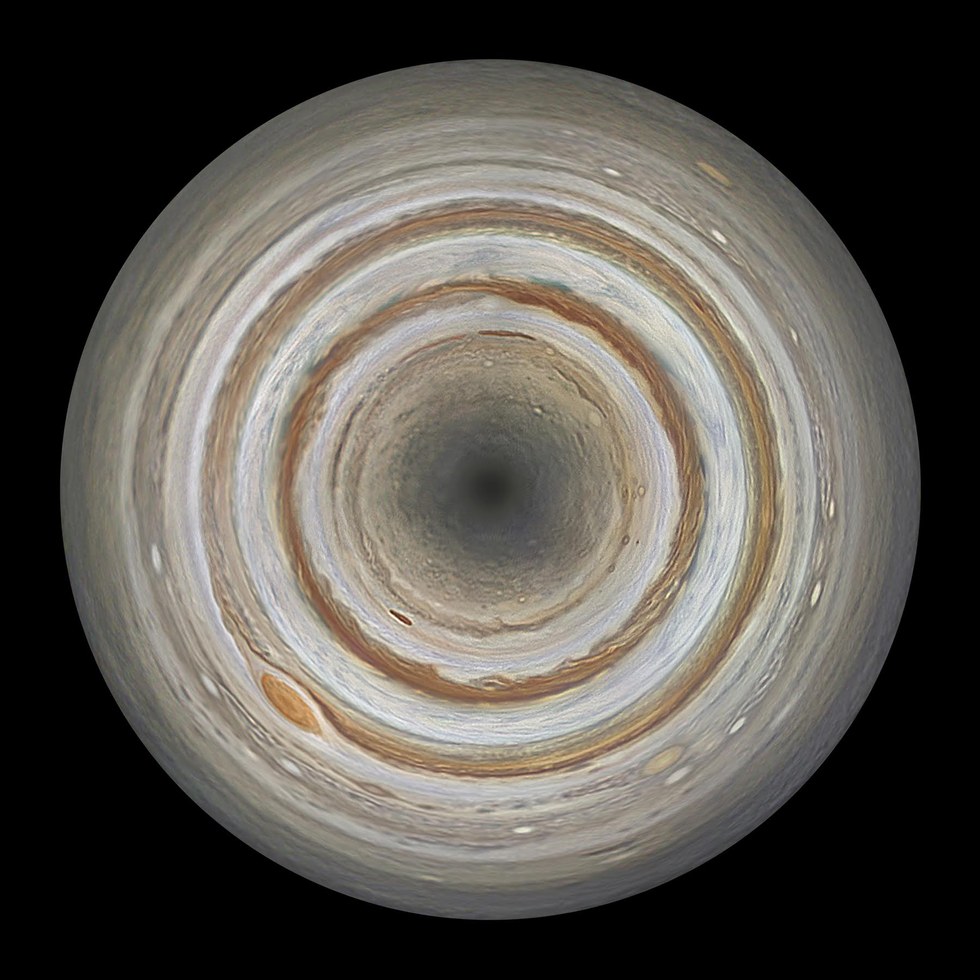Jupiter is a stormy world with turbulent gas and an ever-changing array of visible tempests swirling in the huge planet's clouds.
Eight of those storms are now swirling on Jupiter, and some of them stand out in great detail in a new photo released by NASA this week taken by the agency's Juno spacecraft tasked with exploring Jupiter.
The storms — which look like eight white pearls dotted throughout the planet's southern hemisphere — are rotating counter-clockwise and have been seen by spacecraft before, according to NASA.
"Since 1986, these white ovals have varied in number from six to nine," the space agency said in a statement.

Annotated to point out some of Jupiter's pearl-like storms.
IMAGE: NASA/JPL-CALTECH/SWRI/MSSS
Juno's JunoCam instrument snapped this picture of Jupiter on Dec. 11 as it was about 40,000 miles from the gas giant during the spacecraft's third close pass with Jupiter since it made it into orbit in July.
Scientists working with JunoCam release the images gathered at Jupiter online to allow amateur astronomers and photo editors the chance to process their own images taken by the far-flung spacecraft.
Mission controllers specifically developed JunoCam to encourage the public to get involved with the mission.

An image processed by citizen scientist Alex Mai using data from JunoCam.
IMAGE: NASA/JPL-CALTECH/SWRI/MSSS/MAI

Another processed image of Jupiter.
IMAGE: NASA/JPL-CALTECH/SWRI/MSSS
Scientists working with NASA are asking people around the world with their own telescopes to upload images they take of Jupiter in order to help them pick out which parts of the planet they should photograph during each close pass.
It hasn't exactly been smooth sailing for Juno since it arrived at Jupiter.
Valves used in the spacecraft's fuel system seem to be malfunctioning, preventing mission controllers from moving Juno into a lower orbit that would allow them to gather science more quickly. For the time being, Juno is going to sit tight and collect science from its 53-day orbit until mission managers figure out the root of the issue.
"We have a healthy spacecraft that is performing its mission admirably, and we are able to obtain great science every time we fly by,” Rick Nybakken, project manager for Juno, said in a statement. “What we do not want to do is add any unnecessary risk, so we are moving forward carefully.”
Quelle: Mashable
-
Update: 13.01.2017
.
Crescent Jupiter with the Great Red Spot
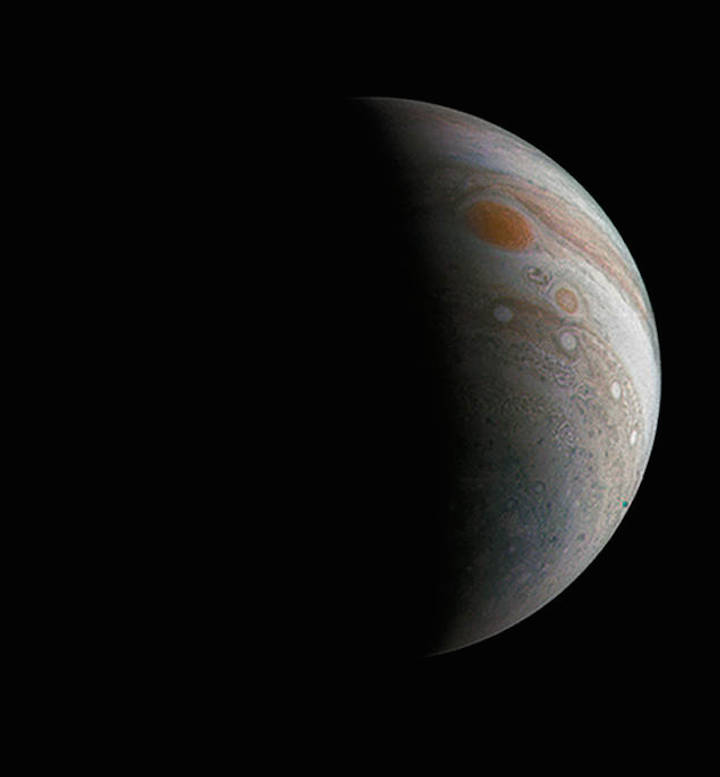
This image of a crescent Jupiter and the iconic Great Red Spot was created by a citizen scientist (Roman Tkachenko) using data from Juno's JunoCam instrument. You can also see a series of storms shaped like white ovals, known informally as the ‘string of pearls.’ Below the Great Red Spot a reddish long-lived storm known as Oval BA is visible.
The image was taken on Dec. 11, 2016 at 2:30 p.m. PST (5:30 p.m. EST), as the Juno spacecraft performed its third close flyby of Jupiter. At the time the image was taken, the spacecraft was about 285,100 miles (458,800 kilometers) from the planet.
JunoCam's raw images are available at www.missionjuno.swri.edu/junocam for the public to peruse and process into image products.
JPL manages the Juno mission for the principal investigator, Scott Bolton, of Southwest Research Institute in San Antonio. Juno is part of NASA's New Frontiers Program, which is managed at NASA's Marshall Space Flight Center in Huntsville, Alabama, for NASA's Science Mission Directorate. Lockheed Martin Space Systems, Denver, built the spacecraft. Caltech in Pasadena, California, manages JPL for NASA.
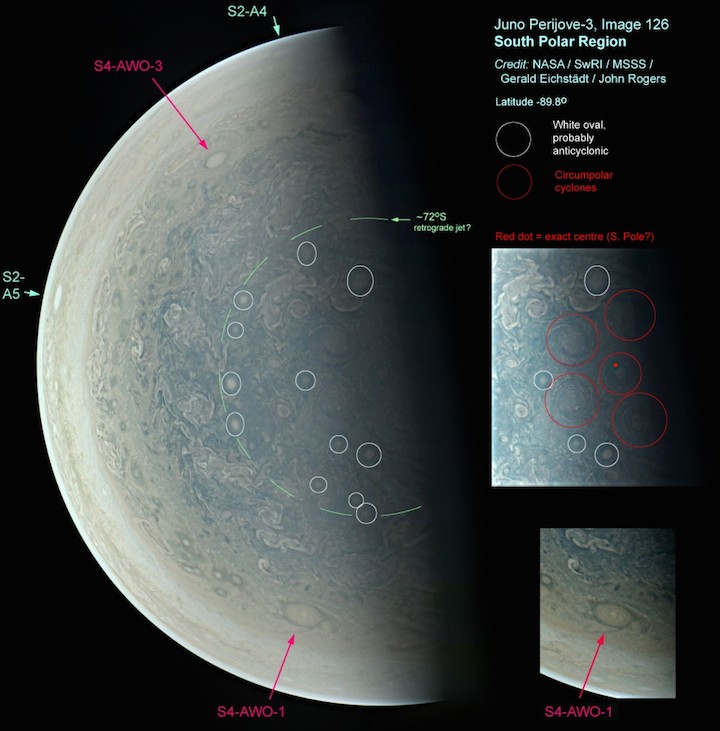
ANNOTATED PJ3 IMAGES: (1) SOUTH POLE
This is the first of a series of posts pointing out features of interest in the perijove-3 images. In many cases I started from versions processed by Gerald Eichstädt, who has devised an algorithm that completely removes the artefactual colou
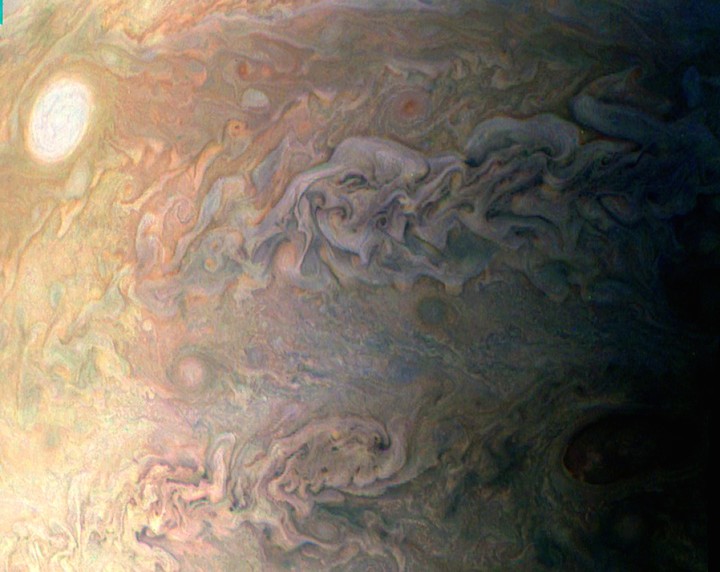
PEARL AND CLOUD TOPS
Pushed saturation and contrast, then cropped to interesting parts.
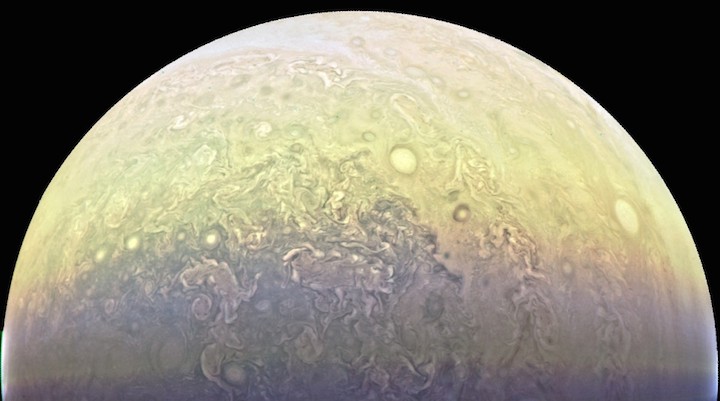
SET345 - CYCLONES, ANTICYCLONES AND TURBULENCES
Image form set 345, rotated, cropped, sharpened, processed with RGB levels, and HDR toning.
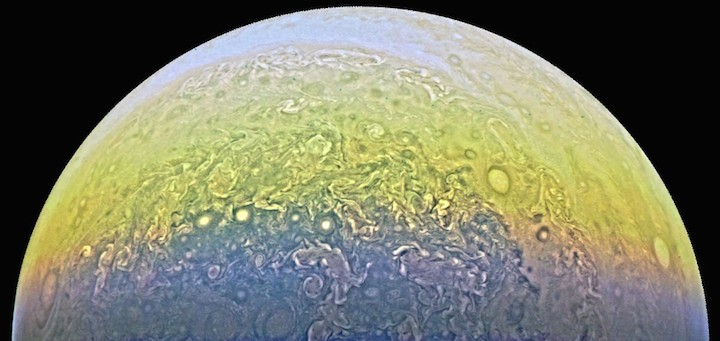
SET 346 - COLORFUL WHIRLWINDS
Image from set 346 rotated, cropped, processed with RGB Levels, sharpened and HDR Toning in PS
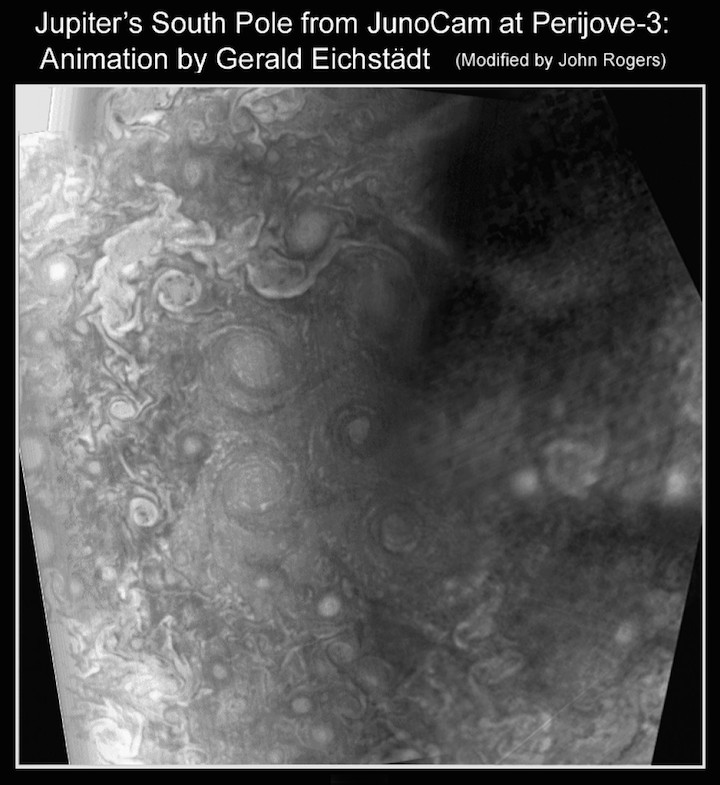
THE FIVE-RING CIRCUS AROUND THE SOUTH POLE
This is a merged version of Gerald Eichstädt’s projected PJ-3 images centred on the South Pole, as shown in the recently-posted animation. (There may still be some distortions.) As it covers one-third of a jovian day, the circumpolar cyclones (CPCs) are revealed all around the pole, and there are indeed 6 of them, 5 being symmetrically placed around the sixth, central, dark one. There is still some uncertainty in the exact location of the pole, but I believe it must be in the centre of that central cyclone. So Jupiter has a pentagonal (not hexagonal) pattern around its south pole. --John Rogers.
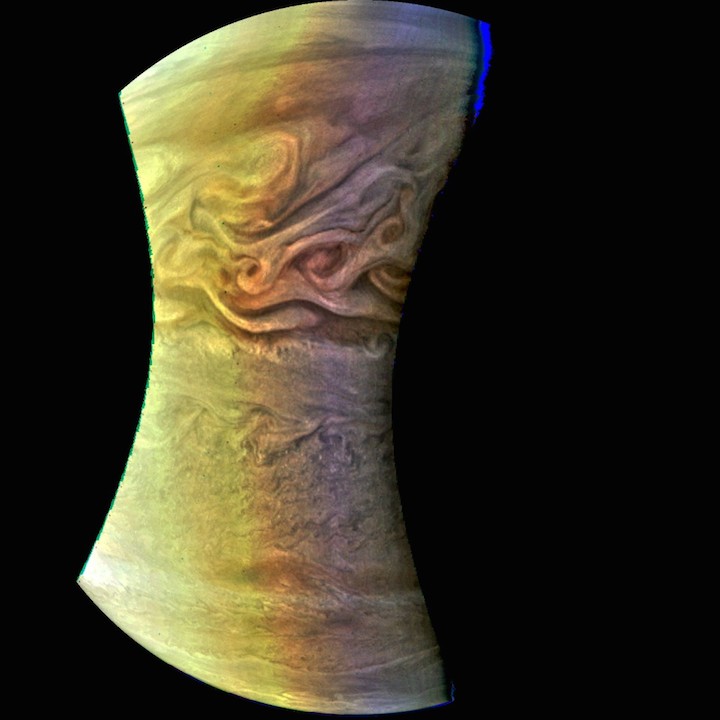
SET 338 ENHANCEMENTS
Composed from RGB images and processed with RGB levels, brightness and contrast, and HDR Toning in Photoshop CS6
Quelle: NASA
.
Update: 20.01.2017
.
Where should NASA’s Juno spacecraft aim its camera during its next close pass of Jupiter on Feb. 2? You can now play a part in the decision. For the first time, members of the public can vote to participate in selecting all pictures to be taken of Jupiter during a Juno flyby. Voting begins Thursday, Jan. 19 at 11 a.m. PST (2 p.m. EST) and concludes on Jan. 23 at 9 a.m. PST (noon EST).
“We are looking forward to people visiting our website and becoming part of the JunoCam imaging team,” said Candy Hansen, Juno co-investigator from the Planetary Science Institute, Tucson, Arizona. “It’s up to the public to determine the best locations in Jupiter’s atmosphere for JunoCam to capture during this flyby.”
NASA’s JunoCam website can be visited at:
https://www.missionjuno.swri.edu/junocam
The voting page for this flyby is available at:
https://www.missionjuno.swri.edu/junocam/voting/
JunoCam will begin taking pictures as the spacecraft approaches Jupiter’s north pole. Two hours later, the imaging will conclude as the spacecraft completes its close flyby, departing from below the gas giant’s south pole. Juno is currently on its fourth orbit around Jupiter. It takes 53 days for Juno to complete one orbit.
“The pictures JunoCam can take depict a narrow swath of territory the spacecraft flies over, so the points of interest imaged can provide a great amount of detail,” said Hansen. “They play a vital role in helping the Juno science team establish what is going on in Jupiter’s atmosphere at any moment. We are looking forward to seeing what people from outside the science team think is important.”
There will be a new voting page for each upcoming flyby of the mission. On each of the pages, several points of interest will be highlighted that are known to come within the JunoCam field of view during the next close approach. Each participant will get a limited number of votes per orbit to devote to the points of interest he or she wants imaged. After the flyby is complete, the raw images will be posted to the JunoCam website, where the public can perform its own processing.
“It is great to be able to share excitement and science from the Juno mission with the public in this way,” said Scott Bolton, Juno principal investigator from the Southwest Research Institute in San Antonio. “Amateur scientists, artists, students and whole classrooms are providing the world with their unique perspectives of Jupiter. I am really pleased that this website is having such a big impact and allowing so many people to join the Juno science team. The public involvement is really affecting how we look at the most massive planetary inhabitant in our solar system.”
During the Feb. 2 flyby, Juno will make its closest approach to Jupiter at 4:58 a.m. PST (7:58 a.m. EST), when the spacecraft is about 2,700 miles (4,300 kilometers) above the planet's swirling clouds.
JunoCam is a color, visible-light camera designed to capture remarkable pictures of Jupiter's poles and cloud tops. As Juno's eyes, it will provide a wide view of Jupiter over the course of the mission, helping to provide context for the spacecraft's other instruments. JunoCam was included on the spacecraft primarily for public engagement purposes, although its images also are helpful to the science team.
---
What would it be like to actually land on Pluto? This movie was made from more than 100 images taken by NASA’s New Horizons spacecraft over six weeks of approach and close flyby in the summer of 2015. The video offers a trip down onto the surface of Pluto -- starting with a distant view of Pluto and its largest moon, Charon -- and leading up to an eventual ride in for a "landing" on the shoreline of Pluto's informally named Sputnik Planitia.
To create a movie that makes viewers feel as if they’re diving into Pluto, mission scientists had to interpolate some of the panchromatic (black and white) frames based on what they know Pluto looks like to make it as smooth and seamless as possible. Low-resolution color from the Ralph color camera aboard New Horizons was then draped over the frames to give the best available, actual color simulation of what it would look like to descend from high altitude to Pluto’s surface.
After a 9.5-year voyage covering more than three billion miles, New Horizons flew through the Pluto system on July 14, 2015, coming within 7,800 miles (12,500 kilometers) of Pluto. Carrying powerful telescopic cameras that could spot features smaller than a football field, New Horizons sent back hundreds of images of Pluto and its moons that show how dynamic and fascinating their surfaces are. Credits: NASA/JHUAPL/SwRI
The original black-and-white “landing” movie can be viewed at:
http://pluto.jhuapl.edu/News-Center/News-Article.php?page=20160714-2
Quelle: NASA
-
Update: 1.02.2017
.
NASA Juno to Fly By Gas Giant Thursday
NASA's Juno spacecraft will make its fourth flyby over Jupiter's mysterious cloud tops on Thursday, Feb. 2, at 4:57 a.m. PST (7:57 a.m. EST, 12:57 UTC).
At the time of closest approach (called perijove), Juno will be about 2,670 miles (4,300 kilometers) above the planet's cloud tops and traveling at a speed of about 129,000 mph (57.8 kilometers per second) relative to the gas giant. All of Juno's eight science instruments, including the Jovian Infrared Auroral Mapper (JIRAM) instrument, will be on and collecting data during the flyby.
"Tomorrow may be 'Groundhog Day' here on Earth, but it's never Groundhog Day when you are flying past Jupiter,” said Scott Bolton, principal investigator of Juno from the Southwest Research Institute in San Antonio. "With every close flyby we are finding something new."
The Juno science team continues to analyze returns from previous flybys. Revelations include that Jupiter's magnetic fields and aurora are bigger and more powerful than originally thought and that the belts and zones that give the gas giant’s cloud top its distinctive look extend deep into the planet’s interior. Peer-reviewed papers with more in-depth science results from Juno’s first three flybys are expected to be published within the next few months. Also, JunoCam, the first interplanetary outreach camera, is now being guided with the assistance from the public -- people can participate by voting for what features on Jupiter should be imaged during each flyby.
Information about JunoCam voting is available at:
http://www.jpl.nasa.gov/news/news.php?feature=6722
Juno is currently in a 53-day orbit period around Jupiter as the team evaluates options for performing a maneuver to get the spacecraft into a shorter orbit period. While the initial plan was for the mission was to have 14-day orbits during this time, Juno can reveal amazing details about Jupiter even if it stays in the longer orbits for the duration of the mission.
Juno launched on Aug. 5, 2011, from Cape Canaveral, Florida, and arrived at Jupiter on July 4, 2016. During its mission of exploration, Juno soars low over the planet's cloud tops -- as close as about 2,600 miles (4,100 kilometers). During these flybys, Juno is probing beneath the obscuring cloud cover of Jupiter and studying its auroras to learn more about the planet's origins, structure, atmosphere and magnetosphere.
NASA's Jet Propulsion Laboratory, Pasadena, California, manages the Juno mission for the principal investigator, Scott Bolton, of Southwest Research Institute in San Antonio. The Juno mission is part of the New Frontiers Program managed by NASA's Marshall Space Flight Center in Huntsville, Alabama, for the Science Mission Directorate. Lockheed Martin Space Systems, Denver, built the spacecraft. JPL is a division of Caltech in Pasadena, California.
Quelle: NASA
-
Update: 6.02.2017
.
NASA Juno Flies By Gas Giant
Updated Feb. 2, 2017 at 3:15 p.m. PST
NASA's Juno mission completed a close flyby of Jupiter on Thursday, Feb. 2, its latest science orbit of the mission.
All of Juno’s science instruments and the spacecraft's JunoCam were operating during the flyby to collect data that is now being returned to Earth. Juno is currently in a 53-day orbit, and its next close flyby of Jupiter will occur on March 27, 2017.
NASA's Juno spacecraft will make its fourth flyby over Jupiter's mysterious cloud tops on Thursday, Feb. 2, at 4:57 a.m. PST (7:57 a.m. EST, 12:57 UTC).
At the time of closest approach (called perijove), Juno will be about 2,670 miles (4,300 kilometers) above the planet's cloud tops and traveling at a speed of about 129,000 mph (57.8 kilometers per second) relative to the gas giant. All of Juno's eight science instruments, including the Jovian Infrared Auroral Mapper (JIRAM) instrument, will be on and collecting data during the flyby.
"Tomorrow may be 'Groundhog Day' here on Earth, but it's never Groundhog Day when you are flying past Jupiter,” said Scott Bolton, principal investigator of Juno from the Southwest Research Institute in San Antonio. "With every close flyby we are finding something new."
The Juno science team continues to analyze returns from previous flybys. Revelations include that Jupiter's magnetic fields and aurora are bigger and more powerful than originally thought and that the belts and zones that give the gas giant’s cloud top its distinctive look extend deep into the planet’s interior. Peer-reviewed papers with more in-depth science results from Juno’s first three flybys are expected to be published within the next few months. Also, JunoCam, the first interplanetary outreach camera, is now being guided with the assistance from the public -- people can participate by voting for what features on Jupiter should be imaged during each flyby.
Juno is currently in a 53-day orbit period around Jupiter as the team evaluates options for performing a maneuver to get the spacecraft into a shorter orbit period. While the initial plan was for the mission was to have 14-day orbits during this time, Juno can reveal amazing details about Jupiter even if it stays in the longer orbits for the duration of the mission.
Juno launched on Aug. 5, 2011, from Cape Canaveral, Florida, and arrived at Jupiter on July 4, 2016. During its mission of exploration, Juno soars low over the planet's cloud tops -- as close as about 2,600 miles (4,100 kilometers). During these flybys, Juno is probing beneath the obscuring cloud cover of Jupiter and studying its auroras to learn more about the planet's origins, structure, atmosphere and magnetosphere.
NASA's Jet Propulsion Laboratory, Pasadena, California, manages the Juno mission for the principal investigator, Scott Bolton, of Southwest Research Institute in San Antonio. The Juno mission is part of the New Frontiers Program managed by NASA's Marshall Space Flight Center in Huntsville, Alabama, for the Science Mission Directorate. Lockheed Martin Space Systems, Denver, built the spacecraft. JPL is a division of Caltech in Pasadena, California.
Quelle: NASA
-
Update: 9.02.2017
.
This enhanced-color image of Jupiter’s south pole and its swirling atmosphere was created by citizen scientist Roman Tkachenko using data from the JunoCam imager on NASA’s Juno spacecraft.
Juno acquired the image, looking directly at the Jovian south pole, on February 2, 2017, at 6:06 a.m. PST (9:06 a.m. EST) from an altitude of about 63,400 miles (102,100 kilometers) above Jupiter's cloud tops. Cyclones swirl around the south pole, and white oval storms can be seen near the limb -- the apparent edge of the planet.
Quelle: NASA
-
Update: 11.02.2017
.
Watch a Stunning Video of Jupiter's Swirling Clouds Made by Amateur Astronomers
This isn't a spacecraft flyby, this is an animation of over a thousand observations of the gas giant from Earth — and it's magnificent.
The swirling belts and bands on Jupiter — along with the planet's raging storms — are some of the most fascinating features in our solar system. While storms like the Great Red Spot have been churning violently for over 150 years, the various zones in Jupiter's cloudtops move in different directions, powered by winds that can exceed 400 miles per hour (620 kilometers per hour).
A famous time-lapse video from the Voyager 1 flyby of Jupiter in 1979 showed us these roiling features and the intense dynamics of the giant planet's atmosphere. But now, a group of 91 amateur astronomers from around the world have combined their efforts to create a video that shows high resolution views of the motion of Jupiter's cloud belts, along with the rotation of the Great Red Spot.
But this was no spacecraft flyby. Incredibly, the images were taken from Earth, and are accelerated by a million times to show the planet's motions at high speed.
The animation of Jupiter was made from more than 1,000 images taken by 91 amateurs from around the world between the December 19, 2014 and March 31, 2015.
"More than a year ago I started a project involving 91 of the best amateur planetary photographers from around the world for a long-term, high-definition monitoring of Jupiter's cloud belts and the revolving Great Red Spot," said Peter Rosén, via email from Sweden, who organized the project. "This result took literally thousands of hours of work."
A projected view of Jupiter's south pole, created from images taken by amateur astronomers around the world (Peter Rosén)
Rosén, and team members Christoffer Svenske and Johan Warell got permission from 91 planetary photographers from around the world use their images for this project. The team worked together to assemble images from their observations, then re-maped them into cylindrical projections. Rosén said the images were color corrected, stacked and seamlessly stitched together into a total of 54 complete maps and then re-maped the images into cylindrical projections to make the imagery look like the planet itself.
"This shows the technical skills of the world-wide community of amateur planetary photographers to be able to reach this high level of details that can be tracked across the planet during 250 revolutions," Rosén told Seeker.
RELATED: Juno Looks Into a Fierce Jupiter Storm During Dramatic Orbital Dive
The light colored bands on Jupiter are called zones, while the dark ones are called belts. In a belt, the winds flow in one direction. In a zone, the winds blow in the opposite direction. According to NASA, the cloud tops are higher in a belt, and lower in a zone.
The belts and zones of Jupiter are labeled in the picture below.
Jupiter and its system of belts and zones. The Red Spot is a hurricane-strength storm that's been present on the planet for at least the past few hundred years (NASA)
Rosén noted that Jupiter's moons don't appear in this animation because it was created from real pictures that focused on the planet itself. But also, the motion of the cloud belts has been accelerated almost one million times, meaning that "the moons would change position so radically between each frame that they would appear more like a swarm of fireflies and be visually very disturbing," he said.
Thanks to Peter Rosén and astrophotographers around the world for providing this incredible view of Jupiter.
WATCH VIDEO: Now Juno Is at Jupiter, Now What?
NASA’s Juno mission to Jupiter, which has been in orbit around the gas giant since July 4, 2016, will remain in its current 53-day orbit for the remainder of the mission. This will allow Juno to accomplish its science goals, while avoiding the risk of a previously-planned engine firing that would have reduced the spacecraft’s orbital period to 14 days.
“Juno is healthy, its science instruments are fully operational, and the data and images we’ve received are nothing short of amazing,” said Thomas Zurbuchen, associate administrator for NASA’s Science Mission Directorate in Washington. “The decision to forego the burn is the right thing to do – preserving a valuable asset so that Juno can continue its exciting journey of discovery.”
Juno has successfully orbited Jupiter four times since arriving at the giant planet, with the most recent orbit completed on Feb. 2. Its next close flyby of Jupiter will be March 27.
The orbital period does not affect the quality of the science collected by Juno on each flyby, since the altitude over Jupiter will be the same at the time of closest approach. In fact, the longer orbit provides new opportunities that allow further exploration of the far reaches of space dominated by Jupiter’s magnetic field, increasing the value of Juno’s research.
During each orbit, Juno soars low over Jupiter’s cloud tops – as close as about 2,600 miles (4,100 kilometers). During these flybys, Juno probes beneath the obscuring cloud cover and studies Jupiter’s auroras to learn more about the planet's origins, structure, atmosphere and magnetosphere.
The original Juno flight plan envisioned the spacecraft looping around Jupiter twice in 53-day orbits, then reducing its orbital period to 14 days for the remainder of the mission. However, two helium check valves that are part of the plumbing for the spacecraft’s main engine did not operate as expected when the propulsion system was pressurized in October. Telemetry from the spacecraft indicated that it took several minutes for the valves to open, while it took only a few seconds during past main engine firings.
“During a thorough review, we looked at multiple scenarios that would place Juno in a shorter-period orbit, but there was concern that another main engine burn could result in a less-than-desirable orbit,” said Rick Nybakken, Juno project manager at NASA’s Jet Propulsion Laboratory (JPL) in Pasadena, California. “The bottom line is a burn represented a risk to completion of Juno’s science objectives.”
Juno’s larger 53-day orbit allows for “bonus science” that wasn’t part of the original mission design. Juno will further explore the far reaches of the Jovian magnetosphere – the region of space dominated by Jupiter’s magnetic field – including the far magnetotail, the southern magnetosphere, and the magnetospheric boundary region called the magnetopause. Understanding magnetospheres and how they interact with the solar wind are key science goals of NASA’s Heliophysics Science Division.
"Another key advantage of the longer orbit is that Juno will spend less time within the strong radiation belts on each orbit,” said Scott Bolton, Juno principal investigator from Southwest Research Institute in San Antonio. “This is significant because radiation has been the main life-limiting factor for Juno.”
Juno will continue to operate within the current budget plan through July 2018, for a total of 12 science orbits. The team can then propose to extend the mission during the next science review cycle. The review process evaluates proposed mission extensions on the merit and value of previous and anticipated science returns.
The Juno science team continues to analyze returns from previous flybys. Revelations include that Jupiter's magnetic fields and aurora are bigger and more powerful than originally thought and that the belts and zones that give the gas giant’s cloud top its distinctive look extend deep into the planet’s interior. Peer-reviewed papers with more in-depth science results from Juno’s first three flybys are expected to be published within the next few months. In addition, the mission's JunoCam – the first interplanetary outreach camera – is now being guided with assistance from the public. People can participate by voting on which features on Jupiter should be imaged during each flyby.
“Juno is providing spectacular results, and we are rewriting our ideas of how giant planets work,” said Bolton. “The science will be just as spectacular as with our original plan.”
JPL manages the Juno mission for NASA. The mission’s principal investigator is Scott Bolton at Southwest Research Institute in San Antonio. The Juno mission is part of the New Frontiers Program managed by NASA's Marshall Space Flight Center in Huntsville, Alabama, for the Science Mission Directorate. Lockheed Martin Space Systems, Denver, built the spacecraft. JPL is managed for NASA by Caltech in Pasadena, California.
Quelle: NASA
-
Update: 21.02.2017
.
NASA decides to leave Juno in current orbit around Jupiter after engine issue

Credit: NASA
NASA made the decision to leave the Juno spacecraft, currently orbiting Jupiter, in its current orbit that cycles around the gas giant every 53 days. The choice hinges on worries surrounding Juno's main engine, which displayed some out-of-the-ordinary readings as the team was preparing to shorten the probe's orbit.
“Juno is healthy, its science instruments are fully operational, and the data and images we’ve received are nothing short of amazing,” said Thomas Zurbuchen, associate administrator for NASA’s Science Mission Directorate in Washington. “The decision to forego the burn is the right thing to do – preserving a valuable asset so that Juno can continue its exciting journey of discovery.”
Juno's original mission plan entailed arriving and Jupiter and performing two 53-day orbits. Then it would fire its main engine and reduce its orbit to 14 days, making more close passes of Jupiter. Those "science passes" are where most of the work gets done, but as the probe was preparing to shorten its orbit, the team found anomalous readings from the engine.
"We wanted to take a really good look at that," said Keith Robinson, Juno's mission manager at the Marshall Space Flight Center in Huntsville, Alabama. "We've got a very valuable asset doing very well."
For the past few months, Juno's mission team at the Jet Propulsion Laboratory in California has been working with Robinson and other NASA staff have been looking at the options and weighing the risks and benefits associated with leaving Juno in its current orbit or firing the main engine.
"We do a piece of it here with the resources we have available and then it all goes into a decision made by the Planetary Science Division at headquarters," Robinson said.
The final decision came on February 17, when NASA HQ decided that firing the engine would be too risky. Juno will remain in its 53 day orbit through the remainder of its mission.
“During a thorough review, we looked at multiple scenarios that would place Juno in a shorter-period orbit, but there was concern that another main engine burn could result in a less-than-desirable orbit,” said Rick Nybakken, Juno project manager at NASA’s Jet Propulsion Laboratory (JPL) in Pasadena, California. “The bottom line is a burn represented a risk to completion of Juno’s science objectives.”
But it's not all bad news. The current orbit avoids the majority of Jupiter's radiation belts, which are an object of concern among the mission team because the strong radiation could fry the onboard electronics.
"Another key advantage of the longer orbit is that Juno will spend less time within the strong radiation belts on each orbit,” said Scott Bolton, Juno principal investigator from Southwest Research Institute in San Antonio. “This is significant because radiation has been the main life-limiting factor for Juno.”
There's also an opportunity for some "bonus science." While Juno will still be able to do most of its mission, it will do it slower because of the lower frequency of close passes. But from its current orbit, Juno has a better view of Jupiter's magneosphere, which creates the gas giant's strong magnetic fields.
Quelle: SPACE ALABAMA
---
Update: 16.03.2017
.
What Should NASA's Jupiter Probe Photograph? Cast Your Vote!

Starting today (March 15), citizen scientists can help decide what the Juno spacecraft will photograph during its next flyby of Jupiter.
On board Juno is an instrument called JunoCam that has already snapped some truly amazing images of the swirling surface of Jupiter's cloudy atmosphere. The raw images from JunoCam are uploaded to the project website, and citizen scientists can download and process those images as they see fit. The processed images have ranged from scientific to artistic.
The JunoCam project is primarily an outreach effort, aimed at letting members of the public participate in multiple aspects of a space exploration mission. In addition to having access to the raw images, members of the public can make suggestions about what JunoCam should photograph during the close flybys. Other members can then vote on those suggestions, and the JunoCam team selects the final targets based on those votes. The current voting period starts today (March 15) and ends on March 20.
Juno is currently on a 53-day orbit of Jupiter; its next close approach will take place on March 27. No other probe in history has ever come this close to the Jovian giant. The spacecraft must orbit Jupiter in a very elongated loop that allows the probe to slip in between the planet and a belt of intense radiationthat surrounds it. Orbiting inside that radiation belt would quickly destroy the spacecraft and the electronics on board.
Because of this deliberate orbital path, Juno only spends a matter of hours in close proximity to Jupiter. In addition, the spacecraft is rotating, so JunoCam can only take pictures when its "eye" is facing the planet. (The instrument has no moving parts.) JunoCam also has a limited amount of data storage — another restriction on the number of images it can capture during a given flyby.
"We take the highest-vote recipient, schedule that and calculate the data volume the image will require," Candy Hansen, a Juno co-investigator and head of the JunoCam team, told Space.com. "Then we move to the next-highest vote getter in the list, schedule that one and continue scheduling images until we run out of data volume."






